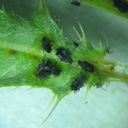Black Bean Aphid
Aphis fabae
Classification
- Phylum: Arthropoda
- Subphylum: Hexapoda
- Class: Insecta
- Order: Hemiptera
- Suborder: Sternorrhyncha
- Superfamily: Aphidoidea
- Family: Aphididae
- Subfamily: Aphidinae
- Tribe: Aphidini
- Subtribe: Aphidina
- Genus: Aphis
- Species: fabae
Pronunciation
How to pronounce Aphis fabae: //ˈæfɪs ˈfeɪ.baɪ//
These audio files are automatically generated. While they are not always 100% accurate, they are a good starting point.
Images






Summary
Aphis fabae, known as the Black Bean Aphid, is a significant agricultural pest with a complex life cycle that includes both asexual and sexual reproduction. It primarily feeds on the sap of various plants and can transmit viruses while causing significant economic impacts through crop damage.
Physical Characteristics
Wingless adults are 1.8-3.1 mm long with an ovoid body, typically green-brown or black. They possess big marginal tubercles on the prothorax and on abdominal segments I and VII. Legs and antennae are light yellow, and the tarsi are brown-black. Winged females (alates) have shiny black heads and thoraxes, with a black-green abdomen.
Identification Tips
Look for small black insects on the undersides of leaves of host plants, characterized by a broad, soft body. Presence of cornicles near the rear of the abdomen, which produce waxy secretions, is also a key identifying feature.
Habitat
Found in various agricultural crops and wild and ornamental plants, typically on the undersides of leaves and growing tips.
Distribution
Native to Europe, introduced to North America in the late 1860s. Found throughout temperate areas including Western Europe, Asia, North America, and cooler parts of Africa, the Middle East, and South America.
Diet
Sucks sap from stems and leaves of host plants, which includes a wide variety of cultivated and wild plants.
Life Cycle
Undergoes both sexual and asexual reproduction; overwinters as eggs on primary host, produces parthenogenetic wingless females in the spring, and migrates to secondary hosts in summer, returning to primary hosts in autumn to reproduce sexually.
Reproduction
Primarily reproduces through parthenogenesis during the summer, producing live young. In autumn, both male and female forms are produced that mate and lay eggs for overwintering.
Predators
Natural predators include ladybirds, lacewings, lacewing larvae, and parasitic wasps such as Diaeretiella and Lysiphlebus which develop within aphids.
Ecosystem Role
Acts as a pest in agricultural systems, can be a vector for plant viruses, and produces honeydew that affects the growth of sooty mold on plants.
Economic Impact
Major pest of sugar beet, beans, and celery crops, leading to stunted growth, reduced crop yield, and contamination of crops.
Collecting Methods
- Hand collection from host plants
- Yellow sticky traps to monitor populations
Preservation Methods
- Ethanol fixation
- Freezing specimens
Evolution
Considered part of the superfamily Aphidoidea, with some taxonomists grouping them as related species or biotypes. Includes several recognized subspecies.
Misconceptions
Often mistaken for similar aphid species; its plant damage is sometimes attributed to other pests.
Tags
- Aphid
- Pest
- Agriculture
- Plant Disease
- Insect